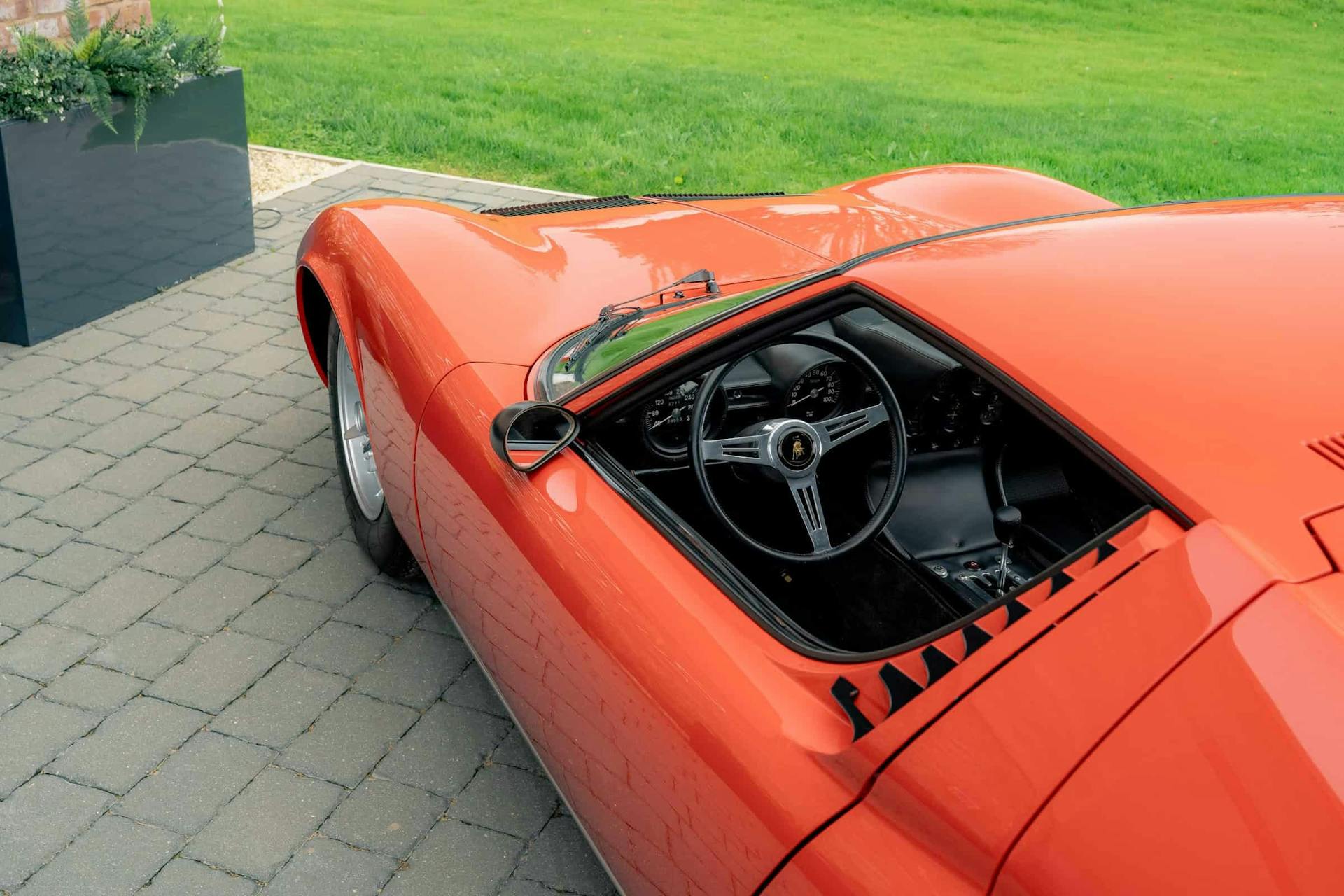1967 Lamborghini Miura

The 1967 Lamborghini Miura P400 – A Revolution in Motion
Unveiled to stunned audiences at the 1966 Geneva Motor Show, the Lamborghini Miura P400 was nothing short of revolutionary. Designed by a young and visionary team of engineers—Gian Paolo Dallara, Paolo Stanzani, and Bob Wallace—working under the ambitious eye of Ferruccio Lamborghini, the Miura rewrote the rulebook for high-performance sports cars.
Prior to the Miura, road cars had largely followed the front-engine, rear-drive format. Lamborghini’s bold move to place a transversely mounted V12 engine amidships was unprecedented for a production road car and more akin to the layout of contemporary race cars. This configuration gave the Miura its now-iconic proportions—long, low, and impossibly sleek—cloaked in a body designed by Marcello Gandini at Bertone, which remains one of the most beautiful automotive forms ever penned.
The original P400, short for Posteriore 4 litri, featured a 3.9-litre V12 engine derived from Lamborghini's earlier GT cars. Producing around 350 horsepower, it enabled the Miura to achieve a top speed of over 170 mph, placing it firmly at the top of the performance hierarchy in the 1960s. The car’s lightweight chassis and low centre of gravity made for exhilarating handling, while the luxury-appointed cabin ensured that it remained a refined grand tourer as well as a supercar.
Production of the Miura P400 ran from 1966 to 1969, with approximately 275 units built before it evolved into the more refined and powerful Miura S. Early P400s, especially those from 1967, are highly prized today for their purity of design and raw driving experience. These cars were built with thinner chassis rails—giving them a lighter, more responsive character—though later cars incorporated structural reinforcements for increased rigidity.
The 1967 model year is particularly significant in the Miura’s legacy. It marked the first full year of production, as Lamborghini rapidly scaled operations to meet unprecedented demand. These cars were assembled with a blend of hand-built craftsmanship and mechanical innovation, offering a driving experience that was unlike anything else on the road.
Despite its relatively short production span, the Miura P400 set the template for every modern supercar that followed. Its combination of exotic engineering, breathtaking aesthetics, and thrilling performance created a new category of automobile—the supercar—and established Lamborghini as a true innovator.
Today, the 1967 Lamborghini Miura P400 is revered as one of the most influential and collectible cars of the 20th century. It represents not only a turning point in automotive design and engineering but also a symbol of the fearless creativity that defined the golden age of motoring.
THIS CAR
1967 Lamborghini Miura P400 – Upgraded to S Specification
Completed on the 29th of May, 1967, Chassis 3009 represents one of the earliest examples of the landmark Miura P400, being the 23rd car produced. Delivered new through the esteemed Italian dealer Monzeglio, it was originally—and remains to this day—finished in the evocative and timeless colour combination of Rosso Miura over Nero Fintapelle.
Following its initial years in Italy, the car made its way across the border to France before eventually crossing the Atlantic to the United States, as was common with many Miuras of the era. In the early 1990s, Chassis 3009 returned to France where it underwent a comprehensive restoration overseen by GTO and the renowned Carrosserie Le Coq in Paris. Originally constructed with the early “thin chassis,” the car received appropriate reinforcements during this meticulous restoration.
At the same time, the then-owner opted to subtly enhance the car’s mechanical specification. These upgrades included the fitment of Miura S brakes, wider SV-type rear wheels and tyres, SV suspension components, and a modernised electrical system, improving both performance and reliability while remaining faithful to the spirit of the model.
Chassis 3009 was proudly exhibited by Le Coq at the 2003 Retromobile Salon in Paris, and its restoration was later featured in Automobiles Classiques, one of France’s most respected motoring publications.
In 2007, the car was entrusted to the workshop of engine specialist Edmond Ciclet in western France. There, a period-correct factory replacement engine was installed and upgraded to desirable split-sump specification. Importantly, the original engine block was retained and remains with the car to this day.
In August 2008, the Miura appeared in the French edition of Classic & Sports Car. Although registered at the time as 15 JR 118, the vehicle appeared in the magazine bearing the registration 6000 TQ 14, a plate associated with a Lamborghini Countach.
Chassis 3009 changed hands in 2013 when it was acquired by renowned enthusiast and collector Mark Ticktum, following its sale by Cecil Cars of Paris. The car was subsequently imported into the United Kingdom, where it benefited from regular servicing by Lamborghini specialists Barkaways.
In October 2016, this notable Miura took part in the official 50th Anniversary Miura Tour through Spain, proudly bearing the UK registration YTA 443E.
Acquired by its current owner—a prominent collector and Lamborghini VIP client—in 2020, Chassis 3009 has been sparingly used, yet well maintained as part of an esteemed collection. Its enduring appeal was once again recognised in April 2022 when it was featured in Classic & Sports Car.
An outstanding early example upgraded with tasteful and well-documented enhancements, Chassis 3009 offers the best of both originality and usability, and stands as a particularly attractive entry into the rarefied world of the Lamborghini Miura.